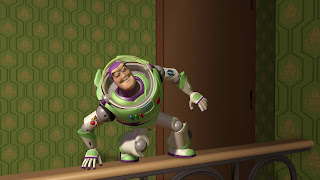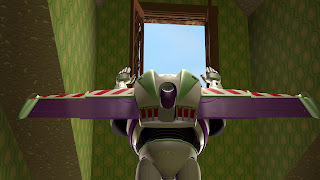For my last post of 2015 (though less than an hour away from 2016), I will be analyzing a scene from Toy Story, my personal favorite Pixar film. Just be sure to bring out some tissues...
So a little context (Spoiler Warning...for the two of you who didn't watch this movie): Woody and Buzz are now trapped in Sid's house by some complicated circumstances and are trying to get back to Andy, their owner. At their first escape attempt, they have split up to hide in different rooms to escape from Scud, Sid's dog. Buzz has happened upon a room with a TV airing a Buzz Lightyear toy commercial. This is where he first learns that he is a toy, not a space ranger he believed himself to be.
Stunned, Buzz turns to his communicator, which cuts to...
..."Made in Taiwan." This is an example of an extreme close-up. The camera (a virtual one, anyway) is extremely close to a subject so that a very small but important detail will be shown. That detail in this shot is the "Made in Taiwan" text.
This is one of many shots of drastic change of emotion in this scene. Here, Buzz goes from shocked to depressed within a span of few seconds. I imagine these shots must have been a nightmare for the animators.
The hallway in this shot seems so empty, as if to complement how empty Buzz must be feeling.
As Buzz is slumping along, the camera is tracking along with him.
And the off-screen source of light has caught his attention as if another truth is being illuminated.
Notice how one piece of the railing is literally separating Buzz from the window. His once-perceived reality as a space ranger who can fly (represented by the sky outside of the window) is now completely out of reach because of his true reality (represented by the railing).
Now, the railings look like prison bars. Even the shape that the railings form looks like he is trapped within it.
The bird further hammers the point home. Flying is not for toys.
"You are a toy, you can't fly!" Woody's words ring in his head.
The shot outside the window creates yet another containment around Buzz with the railing looking like a giant cage. Also, Buzz looks tiny compared to everything. The reality of being a toy makes him feel trapped and worthless.
Suddenly, Buzz's face hardens in defiance and determination all within this one shot.
Shutting up "Made in Taiwan" and thus trying to defy reality.
"No, it can't be true..."
This is an extreme low angle, giving us a sense of danger. What is just a waist-high railing to us is an enormous obstacle to a toy. Buzz is about to accomplish an incredibly daring (or foolish) feat in order to prove to the world and himself once and for all that he really is a space ranger. Going back to the prison imagery of the railings, the shot appears like Buzz is trying to climb over those bars and free himself from that prison of being a flightless toy.
This low-angle shot makes Buzz look powerful, as low-angle shots usually are there to do.
It is also reminiscent of the very first shot of Buzz in the film, when he seemed so threatening to Woody.
"To infinity and beyond!"
At the beginning of this shot, it looks like Buzz just might be able to fly...
...but he isn't.
From this point on, the scene is in slow motion for Buzz and the audience to fully take in the moment of his fall. By seeing the detail of the fall and Buzz's horrified reaction from different angles, our sympathy for him is further heightened. We are feeling Buzz's own humiliation and heartbreak.
And here yet again, we get a drastic change of emotion within the same shot: Buzz's face shifts from determined to horrified.
The window that represented freedom is now getting more and more out of reach.
This moment would last only a few seconds. But to play it in real time would have resulted in a sudden mood shift with little to no transition. Furthermore, for Buzz, his fall would have been so shocking that it would have felt like an eternity. The cinematography of this whole scene compliments Buzz's emotional and psychological state.
There should be a frame of Buzz hitting the stairs here, but I couldn't get it.
As soon as Buzz hits the floor, the slow motion ends, and the scene plays in real time again. The exact moment he hits the floor gets him and the audience out of that trance during the falling.
What we're about to see is a long tracking shot that starts from this close-up of Buzz and ends in a wide shot of the lobby of Sid's house. This close-up is also an overhead shot and a dutch-angle. That is, we are seeing Buzz from above, and the camera has been tilted to convey the chaos and confusion of just having fallen down from a tall height.
As the camera starts to track away, Buzz notices something else to his left, as initially hidden by the tilted camera...
...his broken arm.
The camera stops here for a moment for us to get a good view of Buzz's devastation.
"Clearly, I will go sailing no more..."
Buzz goes back to his toy mode, and the camera speeds up and tracks away and away.
Buzz, with the way he is positioned, now looks like a dead body. In a sense, he - or his perception of life - is dead, completely destroyed by the fall that proves once and for all he is not a space ranger and he can't fly.
The spinning camera also gives a sense of Buzz swirling away from us, as if his life has now spun out of his control.
I'd forgotten how outdated the graphics is for the human characters in this film...
As a child who just found a new toy to play with, Hannah's presence renders whatever Buzz just went through completely meaningless. Since she, just like all humans, is not even aware that toys are alive, it is impossible for her to sympathize with him.
Right after the moment Buzz has realized who is, he is actually fulfilling his purpose - being a plaything.
I apologize if this post was too depressing for you to sit through so close to the New Year.
Thank you for anyone who has been reading my blog, and I hope I'll be able to present better posts for 2016.
Happy New Year!







































































































No comments:
Post a Comment